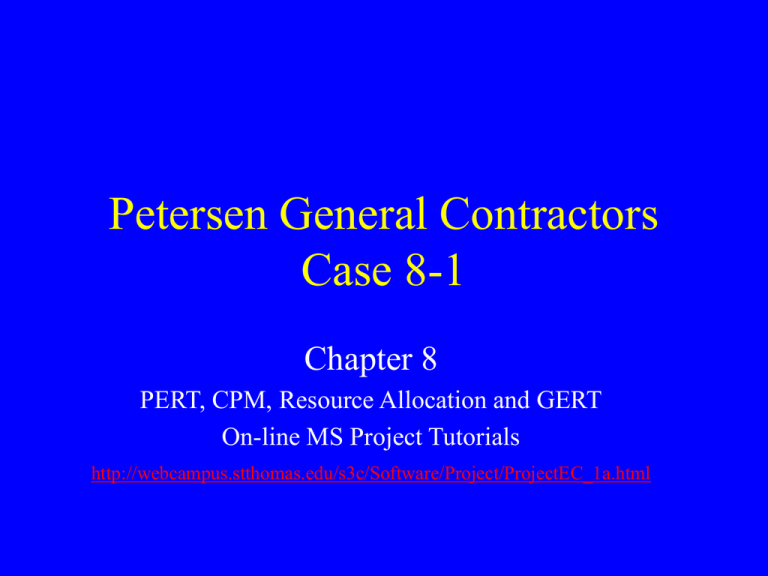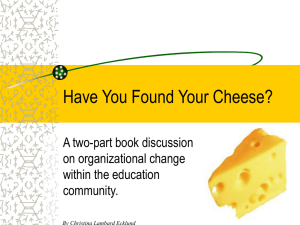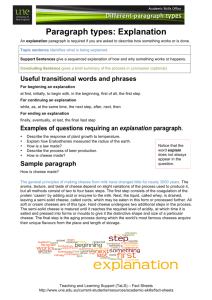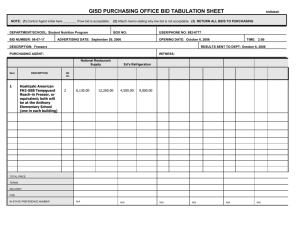Pederson General Contractors Case 8-1
advertisement

Petersen General Contractors Case 8-1 Chapter 8 PERT, CPM, Resource Allocation and GERT On-line MS Project Tutorials http://webcampus.stthomas.edu/s3c/Software/Project/ProjectEC_1a.html Team Alternative • Form teams of five or fewer – Identify the task of each team member – Rate the contribution of each member Teams 2,3,and 4 Team 1 Real World Considerations • Other concurrent projects (size of total commitments) • Coordinating with other companies (structure) • Have you ever built a TV Tower? (technology) • What is the basis for the estimators estimate? – Is company experience still valid? – Is 15% for contingencies still appropriate? Structure Technology Thankfully this is not the real world. Size Tasks with MS Project Team One • Manage the other teams • Do a post mortem – Identify the benefits of a team approach – Identify the issues encountered – Characterize your team Team Two - At normal rate • In how many days can the job be completed? • What bid will yield a 10% pre tax profit? • To reduce risk, what are the key tasks to watch? Team Three - At the fastest time: • In how many days can the job be completed • What bid will yield a 10% pre tax profit? • To reduce risk, what are the key tasks to watch? Team four • If cost is not a consideration, what else can be done to shorten the project? • Address real world issues Deliverables short written reposts • • • Team One - Reality of managing this project Teams Two and Three - MS Project based appropriate network diagrams for each time scenario identifying: – Key events – Dependencies – Cost estimates for each time scenario Team Four – Using team one and two's analysis, provide a list of alternatives for: • Shortening the project if cost is not an object • Further reducing costs – Address the real world issues FAQs • Yes, you will work in teams • Yes, this is a project within a project • • • Others? Petersen General Contractors Case 8-1 the book answer At a Normal Rate • Time – The critical path, a a-f-h-i-v-k-cc-ee = 224 days – Next longest path is a-b-c-l-n-m-p-q-r-s-u-ee = 200 days At a Normal Rate $500 Direct cost are 50% Costs – Total direct costs = $364,050 • Direct labor = $206,280 • Direct material = $157,770 – + Indirect costs @ 65% of direct cost = $600,682.50 – + Contingency @ 15% of direct plus indirect cost = $690,784.87 – + Bid with 10% profit = $759,863.35 Shortest Possible Time same path new time 29 25 4 25 4 30 • Time – The critical path, a a-f-h-i-v-k-cc-ee = 191 days – Second critical path is a-b-c-l-n-m-p-q-r-s-u-ee = 191 days 3 14 Shortest Possible Time same path new time, new cost Time is money Costs – Total direct costs = $383,813.20 • Direct labor = $226,043.20 – Activities on the critical path increase = $16,320 – Activities on the second critical path = $3443.20 • Direct material = $157,770 – + Indirect costs and contingency = $728,285.54 – + Bid with 10% profit = $801,114.10 (plus $41,250.25 for 35 days) What to Supervise More Carefully • • • • • • Near critical paths Areas of new technology or technique New staff High risk items Any “high visibility” items Others Glass, china and reputation are easily broken And never well mended. Ben Franklin If “Shortest” is Still Too Long • Sub contract sub assemblies • Buy a tower and transport it • Others? Think out of the box Some Leading Authors Idea-Based Leadership Yes No • Ensure the presence and respect for idea practitioners • Set forth an idea strategy in a idea-friendly culture • Be open to ideas and the people who suggest them • Reward the practitioners • Signal the importance of ideas How does your organization rate and why Source: What’s the Bid Idea Thomas Davenport, and Laurence Prusak with H. James Wilson Breaking Through to Innovation • Technology = arrangement of objects, ideas and people to accomplish a goal • Technology brokering = exploiting existing technologies to create new ones • Innovation is not breaking free of the past; it is harnessing the past in new ways Your perspective and knowledge Others perspective and knowledge Source: How Breakthroughs Happen Andrew Hargadon Deep Shallow Depth The Balancing Act New Ideas Actionable Dogma Networking Jack of all trades Master of none Inside Outside Source: How Breakthroughs Happen Andrew Hargadon Breath "Knowledge" is both the raw material for innovation and "comfort" that inhibit seeking new opportunities outside of your comfort zone. The Rules • • • • • • • • • Never forget the future is already here. Analogy trumps invention Find your discomfort zone Divided we innovate. Bridge to your strengths Build to your weakness Build teams As goes the individual, so goes the organization Source: Rip, mix and burn How Breakthroughs Happen Andrew Hargadon Efficiency – Innovation Dichotomy Efficiency Stay in Business Innovation Today’s Business Climate Source: Creating the Innovation Culture Frances Hribe Honoring the Dissenters Foster Innovation • Dissenters offer new ideas • Force others to challenge their assumptions • Dissent can: – Kill wrong or out of date ideas – Tap into peoples tacit (gut) knowledge – Break you out of a think rut SOW Source: Creating the Innovation Culture Frances Hribe How to Kill Dissent (Innovation) Without Really Trying • Best practices – make the status quo better • Treat everybody equally – no one is a valuable resource who's ideas count • Hire a mini me – all run down the same train of thought • Design a process for innovation – oxymoronic? Source: Creating the Innovation Culture Frances Hribe How to Foster Innovation • • • • • Speak last in meetings Seek out dissenter’s view Protect the dissenter Help dissenter be heard Challenge the Status Quo Source: Creating the Innovation Culture Frances Hribe 80 /20 and You 19th Century – Vilfredo Pareto • A small minority (20%) account for a majority (80%) of the wealth 20th Century – Joseph Juran • Solving quality problems depends on differentiation the vital few cause from the trivial many. Every job should leverage your 20% genius 80% of the time Source: Richard Koch 80/20 Individual Out of the Box Thinking Problems Looking for a Solution •If resources were no object •Walk in the others shoes •Budgets and Schedules •Self Interest •Silos and Turf •Good Enough Solutions Looking for a Problem •Where else would it fit •Do it the opposite way Source: Why Not Bary Nalebuff and Ian Ayres Selling your Ideas • • • • Elevator pitch KISS – keep is similar silly Know to whom to pitch Make it their idea Source: Why Not Bary Nalebuff and Ian Ayres The Capability to Innovate • • • • • Process People Strategy and Customers Technology Measures and Performance Source: 24/7 Innovation Stephen M. Shapiro Process The “re’s” • • • • • • • Rethink Reconfigure Re-sequence Relocate Reduce Reassign Retool Phrase Problems in Ways They Can Be Solved… • • • • How to…………. (H2) How might……….. (HM) In what ways might…….(IWWM) What might………….(WM) Do it globally Source: Dave Labno Innovation Consultant Slides not Used Who Moved My Cheese Source: Spencer Johnson Who Moved My Cheese What would you do if you weren’t afraid? We all approach EC Change Differently • Sniff – Sniffs out the situation and sees early • Scurry – Goes into action immediately • Hem – Does not want to deal with change and stays in familiar territory • Haw - Sees what he is doing is wrong, laughs at himself, and finally changes Haw’s Writing on the Wall • Change happens, they keep moving the cheese • Anticipate change – get ready for the cheese to move • Monitor change – smell the cheese often • Adapt to change quickly • Enjoy change – savor the adventure • Be ready to change quickly and enjoy it again. They keep moving the cheese Known Hidden Tell Open Unknown Ask Know to Self The Johari Window Unknown Unknown Blind Known Known to Others Pareto – Yesterday and Today Managerial Capitalism • • • • • • • • Individualism Corporations created wealth Jobs are repetitive & labor intensive Managers – Theory X Shareholders consume wealth • • Capital is king Centralized planning yields strategic goals Economies of scale and mass production Mangers are focus of power • • • • • • Individuals create wealth Few employees &creative imagination Coaches - Theory Y and Z Venture capitalist and entrepreneurs share the wealth Creativity is critical element Agility & contractual relationships Mass customization Companies reunite ownership and control Source: Richard Koch 80/20 Individual Customer Strategies • • • • Add more value Listen Serve Hire Creating a Culture of Innovation • • • • Envision Enable Explode “EmpowerTool” Technology and Innovation • • • • • Create a virtual enterprise Change the rules of the game Collaborate across the value chain Increase the knowledge of employees Launch new businesses • • • • • • Alliance Based Capability Bases Process Dominated Process Driven Process Sensitive Functionally Bound Stages Getting There






